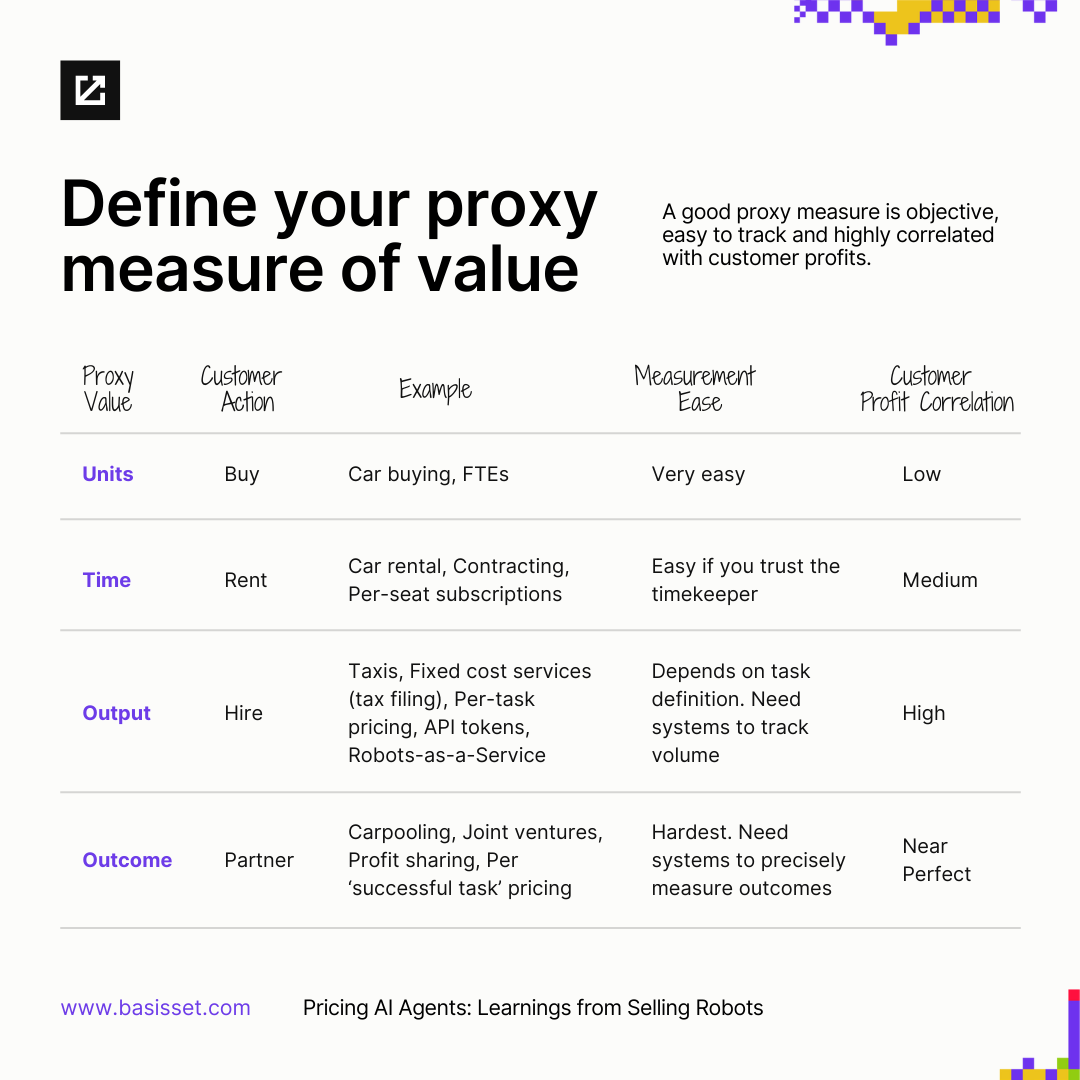Pricing AI Agents: Learnings from Pricing & Selling Robots

August 19 2025
By Sébastien Boyer, President of Zeffy, Founder of Farmwise & Basis Set Venture Partner
One of the topics that I talk about the most with founders these days is pricing models. Figuring out a pricing model used to be a non-question for most B2B SaaS founders because of the ubiquitous “per seat” model, so it's not surprising that most of them, even experienced ones, typically have had very little exposure to thinking and exploring different pricing models.
In the old SaaS world, more users almost always meant more value created. Now, the more value you create, the fewer users you should have. Pricing models are more of a topic now than before. As a robotics founder that sold automation, pricing models are something I have spent some time experimenting with, so I am sharing below a few learnings I had.
TLDR: How I like to approach pricing questions for AI agents (or robots):
- Define the best proxy measure of the value for the increased profits you generate for your B2B customer
- Quantify the relationship between this proxy measure and customer profits $ ~ aka build the ROI case
- Try and test until you build an intuition for what % of that value you can acceptably capture
Choosing a good proxy measure of value created
When building semi-autonomous 2 ton weed killer robots, a “per seat” pricing model is not even something you dare to put on the white board. The number of users has never been a good proxy measure for value created by robotics companies. AI companies trying to automate face similar challenges.
As we commercially rolled out our robots to farmers, we sequentially explored four pricing models.
- To Buy - aka selling robot units. This was our natural first guess as this is what the entire farming industry is used to - as a farmer you go to your dealer and purchase a new tractor every 5 to 7 years. This quickly proved early on to be impossible for us because our robots were not mature enough initially. They were changing all the time (through software updates and physical hardware upgrades), were not trusted by customers yet (rightfully so, we didn’t trust them either) and they were too expensive (a few $100k per unit representing a double digit % of yearly capital expenses for most of our customers).
- To Rent - aka selling time. This was a natural next phase of exploration as it solved all the issues of unit-based pricing: we could update / upgrade the robot whenever we wanted to unlock continuous improvements in parallel to rolling out commercial deployments, the customers could now “try” at low risk and they didn’t have to lay out a significant amount of cash investment upfront. It didn’t solve all of our issues. When customers ran the robots themselves, productivity cratered. Farm operators drove tractors and fixed mechanical issues, but our machines also needed someone who could debug software and set field parameters. The same time spent with the robot didn’t always result in the same outcome and in our case, the customer was consistently less productive than we were with our own product.
- To Hire - aka selling output. We ended up running the ops ourselves — hiring and training operators, buying trucks, renting service centers — and charging for acres cleared of weeds. Farmers didn’t have to provide labor and ROI was easy to explain: “We save you X on labor and chemicals per acre.” It was complex operationally, but it was very straightforward for our customers. It allowed us to remove the risk from their hands and keep it in ours. It also allowed us to quickly iterate on the product while expanding our commercial footprint. I am now convinced it was the best model for us to get started. We only moved away from it much later, when the product was mature enough such that we didn’t have the problems mentioned in 1 and the scale was large enough such that the operational overhead was too big. People in the robotics world refer to this as the Robot-as-a-Service model.
- Partnership - aka sharing profits. By co-owning the farm, we could have simply benefited from the extra profit generated by using our own robots on “our” farms. We never explored this seriously as an independent company because of the obvious financial and operational overhead. We ended up selling Farmwise to Taylor Farms, the largest vegetable producer in the world, which has integrated Farmwise robots into their operations and is now benefiting from increased productivity. In a sense, this was our final pricing model. s

Quantifying the relationship between proxy measure and value
Unlike in very specific cases, you end up relying on an imperfect measure of value (units, time, output and even outcomes are imperfect approximations of customer profits). Most of your sales efforts are therefore dedicated to proving to your customer that 1) the proxy you use is highly correlated with their profits and 2) that the specific quantitative relationship between the two is your price.
With our “per acre” pricing model, we were left with the difficult job of quantifying the value created “per acre” for our customers.
- Quality of the output — We had to match or beat their current methods (manual crews, chemical spraying). We ran before/after trials, invited them to inspect fields themselves, tested across crop types, soil types and weed densities. We sometimes ran A/B tests over the full cycle of crops (though we abandoned that method because it was too time consuming). Eventually we could win them over by having them visually inspect just a few fields. One of the main reasons why I have always believed that “weeding” was going to be the first successful use case for robotics in farming is how easy it is to “check the quality of the work,” because an expert eye only needed a few minutes on a field to be convinced.
- Value of the quality — Many customers didn’t have spreadsheet saying, “Here’s what perfect weeding is worth to us.” We sat with both the field manager and the CFO to model savings in chemicals and labor for every acre. We helped them link this quality effort to their bottom line. Once they believed those savings, “per acre” became a proxy they trusted.
Advantages and challenges of the Agent-as-a-Service pricing model
The shift to proxy measures that are closer to actual customer profits is happening in most industries as they roll out AI-native products and services.

These variations of Agent-as-a-Service pricing models offer unique advantages compared to their pre-AI counterparts
- Aligns better with customer value. The closer you get to their bottom line, the easier it is to sell. “Per outcome” is much easier to defend than “per seat” or “per hour” because the relationship between the proxy measure and actual value is easier to quantify.
- Gives you the control and the short term benefits of the efficiency gains. Early products are immature — outcome-based pricing gives you room to improve while still getting paid for real-world use. The more efficient you are, the higher your margins. You control your own destiny.
My personal checklist to approach AI or robot pricing:
- Define your proxy measure for value. A good proxy measure is objective, easy to track and highly correlated with customer profits.
- Quantify the relationship between your proxy measure value of profit and actual customer profits. This is sometimes called “build a customer ROI model." This is critical to understand before starting to sell.
- Define how much of that value is acceptable for you to capture. This highly depends on competitive dynamics in your industry. Large monopolists in agriculture aim to capture 30% of the value they create. My personal target range is 20% to 50%. Anything above that shows that you have amazing differentiation or protectability (or that you are measuring value incorrectly). Anything below this and you are entering commodity territory (or again you are measuring value incorrectly).